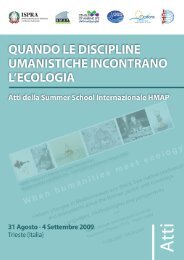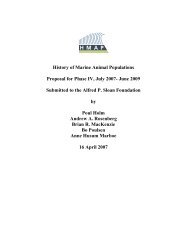The Danish fisheries c.1450-1800. Medieval and early modern ...
The Danish fisheries c.1450-1800. Medieval and early modern ...
The Danish fisheries c.1450-1800. Medieval and early modern ...
You also want an ePaper? Increase the reach of your titles
YUMPU automatically turns print PDFs into web optimized ePapers that Google loves.
we do not have a price series of <strong>Danish</strong> fish that is immediately relevant to our problem. We<br />
know that after a peak around 1450, fish prices fell through the sixteenth century relative to<br />
agricultural prices. Arnved Nedkvitne has published three series of data relating the<br />
purchasing power of dried cod to grain on the Dutch, English <strong>and</strong> Norwegian markets, which<br />
throw light on the decline. 24 Whereas one kilogramme of dried fish would have bought<br />
fourteen kg of wheat on the London market around 1400, at the end of the sixteenth century it<br />
bought only six kg. Similar evidence from Holl<strong>and</strong> shows that dried cod lost almost half its<br />
purchasing power relative to rye during the sixteenth century, <strong>and</strong> on the Bergen market the<br />
purchasing power was more than halved between 1400 <strong>and</strong> 1500 <strong>and</strong> halved again in the next<br />
hundred years. A similar development concerning herring may be calculated from the German<br />
evidence presented by Bauernfeind; between 1450 <strong>and</strong> 1550 herring lost half of its value<br />
relative to rye at the Nuremburg market, <strong>and</strong> continued declining in the seventeenth century,<br />
except for some very good years around 1617-22. 25 Evidence from the neighbouring North<br />
European countries concerning both cod <strong>and</strong> herring thus shows a significant drop in the price<br />
of fish relative to agricultural products from the late medieval to the <strong>early</strong> <strong>modern</strong> ages. In the<br />
Netherl<strong>and</strong>s, the relative price fall was counterbalanced by exp<strong>and</strong>ing deep-sea catches by<br />
larger <strong>and</strong> more productive ships. In Denmark, fishermen were apparently unable to afford<br />
larger ships <strong>and</strong> were pushed out of the fishing sector by poor prices.<br />
<strong>The</strong> adverse trend of fish prices relative to agricultural prices continued through the<br />
eighteenth century. <strong>The</strong> price series from the Copenhagen fish market below shows that<br />
herring became cheaper as compared to the price of bread, thus worsening the purchasing<br />
power of fishermen relative to peasants. <strong>The</strong> spring herring came from the Limfiord, while the<br />
autumn herring most probably came from the Sound <strong>and</strong> North Zeal<strong>and</strong> <strong>fisheries</strong>. <strong>The</strong> only<br />
24 Arnved Nedkvitne, “Mens Bønderne seilte og Jægterne for.” Nordnorsk og vestnorsk<br />
kystøkonomi 1500-1730 (Oslo, 1988).






